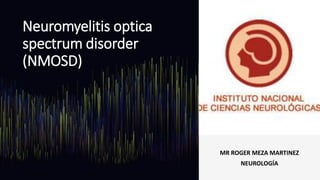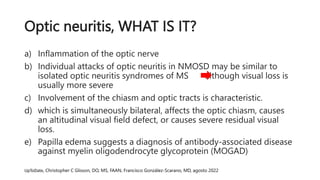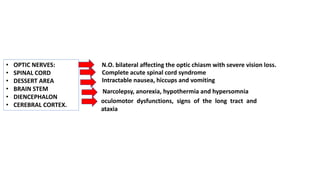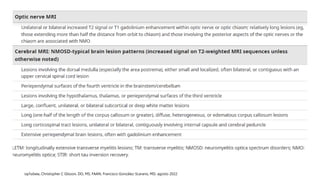Neuromyelitis optica spectrum disorder (NMOSD).pptx
- 1. Neuromyelitis optica spectrum disorder (NMOSD) MR ROGER MEZA MARTINEZ NEUROLOG├ŹA
- 2. INTRODUCTION ŌĆó previously known as Devic disease or neuromyelitis optica (NMO) ŌĆó Is an inflammatory disorder of the central nervous system. ŌĆó Immune-mediated demyelination and axonal damage predominantly targeting optic nerves and the spinal cord. UpToDate, Christopher C Glisson, DO, MS, FAAN, Francisco Gonz├Īlez-Scarano, MD, agosto 2022
- 4. EPIDEMIOLOGY ŌĆó In adults 0,37 a 10 por 100.000 ŌĆó Women is up to 10 times higher than in men ŌĆó Age is 32 to 41 years old (Comparatively the mean age of onset of MS is 24 years) UpToDate, Christopher C Glisson, DO, MS, FAAN, Francisco Gonz├Īlez-Scarano, MD, agosto 2022
- 5. PATHOGENESIS a) Neuropathology: involve multiple segments of the spinal cord and optic nerves with astrocyte death, axonal loss, perivascular lymphocytic infiltration, and associated vascular proliferation. b) Autoimmune pathogenesis: mediated primarily by the humoral immune system c) Astrocytopathy: which causes immune-mediated inflammation and secondary demyelination d) AQP4 water channel protein: NMO-IgG target antigen is a water channel protein that is abundant in the astrocytic processes of the foot in the blood-brain barrier and is highly concentrated in the gray matter of the spinal cord UpToDate, Christopher C Glisson, DO, MS, FAAN, Francisco Gonz├Īlez-Scarano, MD, agosto 2022
- 6. The target antigen: AQP4 Is expressed in: ŌĆó Optic nerve ŌĆó Spinal cord ŌĆó The periventricular areas, hypothalamus and subpial regions, ŌĆó Brainstem and the area postrema
- 7. Neuromyelitis optica: State of the art Jorge Daza Barriga1 , Ang├®lica Roncallo Del Portillo 2017
- 8. CLINICAL FEATURES ŌĆó Spectrum of symptoms ’ā╝ acute attacks of bilateral or rapidly sequential optic neuritis. ’ā╝ transverse mielitis with a typically recurring course ’ā╝ Other symptoms: intractable nausea, vomiting, hiccups, excessive daytime sleepiness, or narcolepsy UpToDate, Christopher C Glisson, DO, MS, FAAN, Francisco Gonz├Īlez-Scarano, MD, agosto 2022
- 9. Optic neuritis, WHAT IS IT? a) Inflammation of the optic nerve b) Individual attacks of optic neuritis in NMOSD may be similar to isolated optic neuritis syndromes of MS although visual loss is usually more severe c) Involvement of the chiasm and optic tracts is characteristic. d) which is simultaneously bilateral, affects the optic chiasm, causes an altitudinal visual field defect, or causes severe residual visual loss. e) Papilla edema suggests a diagnosis of antibody-associated disease against myelin oligodendrocyte glycoprotein (MOGAD) UpToDate, Christopher C Glisson, DO, MS, FAAN, Francisco Gonz├Īlez-Scarano, MD, agosto 2022
- 10. ŌĆó VISUAL EVOKED POTENTIAL :They show increased latency and decreased wave amplitude, observed in more than 65% ŌĆó Desaturation to the red color is altered in 88%. ŌĆó afferent pupillary defect is an extremely sensitive indicator ŌĆó pain related to eye movements
- 11. ŌĆó OPTIC NERVES: ŌĆó SPINAL CORD ŌĆó DESSERT AREA ŌĆó BRAIN STEM ŌĆó DIENCEPHALON ŌĆó CEREBRAL CORTEX. N.O. bilateral affecting the optic chiasm with severe vision loss. Intractable nausea, hiccups and vomiting Complete acute spinal cord syndrome oculomotor dysfunctions, signs of the long tract and ataxia Narcolepsy, anorexia, hypothermia and hypersomnia
- 12. UpToDate, Christopher C Glisson, DO, MS, FAAN, Francisco Gonz├Īlez-Scarano, MD, agosto 2022
- 13. UpToDate, Christopher C Glisson, DO, MS, FAAN, Francisco Gonz├Īlez-Scarano, MD, agosto 2022
- 14. UpToDate, Christopher C Glisson, DO, MS, FAAN, Francisco Gonz├Īlez-Scarano, MD, agosto 2022
- 15. UpToDate, Christopher C Glisson, DO, MS, FAAN, Francisco Gonz├Īlez-Scarano, MD, agosto 2022
- 16. UpToDate, Christopher C Glisson, DO, MS, FAAN, Francisco Gonz├Īlez-Scarano, MD, agosto 2022
- 19. UpToDate, Christopher C Glisson, DO, MS, FAAN, Francisco Gonz├Īlez-Scarano, MD, agosto 2022
- 20. UpToDate, Christopher C Glisson, DO, MS, FAAN, Francisco Gonz├Īlez-Scarano, MD, agosto 2022
- 21. UpToDate, Christopher C Glisson, DO, MS, FAAN, Francisco Gonz├Īlez-Scarano, MD, agosto 2022
- 22. UpToDate, Christopher C Glisson, DO, MS, FAAN, Francisco Gonz├Īlez-Scarano, MD, agosto 2022
- 23. Optical coherence tomography: ŌĆó report a thinning of the nerve fiber layer of the retina, reflecting more severe axonal aggression. ŌĆó Microcystic macular edema of the inner nuclear layer ŌĆó reduced ganglion cell thickness UpToDate, Christopher C Glisson, DO, MS, FAAN, Francisco Gonz├Īlez-Scarano, MD, agosto 2022
- 24. Thank you, we are improving English speaking
























